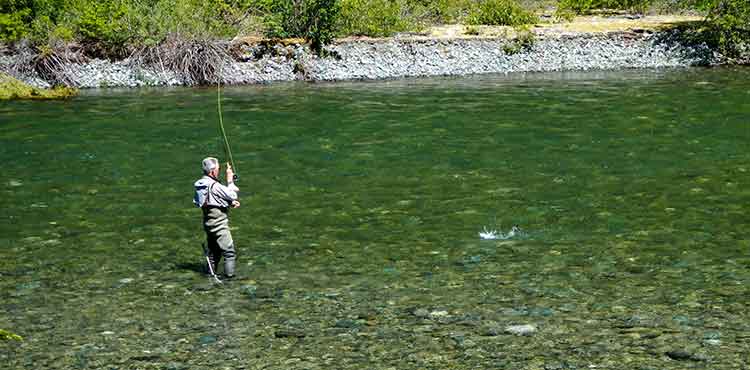
By Rory E. Glennie
For fly fishers, shallow water is a relative term. For most of us it means water less than three feet deep. Many of the best places on streams and along salt-water beaches, where fly fishing is often most effective, are only this deep. Some anglers find it surprising, but good-sized fish can and do utilize these shallow areas for feeding and resting until they are disturbed and scurry away to the depths.
Do Not Just Barge In
Particularly when a stream is a bit coloured with runoff silt, steelhead and salmon will often lie in the soft water very close to the shore. They seem to feel comfortable hidden by the murk. Sea-run cutthroat trout regularly prowl the estuary shoreline, feeding on whatever they find in water less than knee deep, even on sunny days. Many lake edges have trout that will nose right into the reeds to find food. The lesson here? Fish through those areas before taking that first intrusive step into the water.
Tail-Outs and Shrunken Streams
Shallow water tapering off into a riffle at the tail-out of a pool is a classic illustration of shallow water. The gentle upwelling flow as the water rises to spill out of the pool provides a resting area for travelling fish and a steady chow line for those feeding. As stream levels drop, what was a good deep spot becomes a low water haven. That piece of water has now become shallow enough to cover effectively with a fly. Additionally, the white water spilling in at the head of a miniature pool, which is now only a couple of feet deep, offers fish overhead obscurity and safety from avian predators.

Gearing Up to Get Down
The old adage says “You cannot fish your fly five feet deep in three feet of water.” So, the most useful fly line to use for fishing shallow waters is the full floating line. On occasion, especially off the beaches where salt water is more buoyant than fresh, a floater with a short intermediate sink rate tip may be beneficial. Utilizing a floating line does not automatically imply using a surface fly, but it is the best line for doing just that.
Depending on species of fish sought, even shallow water may dictate getting the fly down into their face. Fly patterns designed to sink rapidly—like the Clouser Deep Minnow or various bead-head nymphs—are very useful in sounding the near bottom. In streams, drifting a heavy fly through a short, shallow area often means a quickly repeated series of line lifts and recasts. Visualize this technique as a rototiller cutting its way through fresh earth on every pass around: i.e. Cast upstream, follow the drift down with the rod tip, let the fly swing up at the end of the drift, repeat. When attached to a longish leader these weighted flies are effective and efficient fish catchers in shallow water.
For those species willing to rise to the fly, think of it this way: For a surface fly presentation in shallow water, there is less distance between the fish and the fly. That factor alone often accounts for whether or not a fish will rise to the surface to take your offering; less effort expended for calories gained.
Not Only the Edges
Shallow water offers the fly fisher an extended range of wading opportunity. Those far-out fishy spots can now be efficiently and stealthily approached. Longer fly rods, say ten feet and longer, afford the fisher greater line, and therefore greater fly control. Fishing “fine and far-off” is not the norm in shallow water. It is more like a close-in contest of skill and cunning. Other than when shallow water edges are masked with coloured water, expect shallow water to be clear or fairly clear. Go slow, trying not to make an underwater racket by shifting rocks. Install a rubber tip on your wading staff so not to telegraph your presence via metallic underwater Morse code. Be cognizant of where your shadow falls; do not spook the fish before you get close enough to make your cast. Ditto for shiny objects attached to a fly vest or the flash from a polished fly rod—tone them down wherever possible.
Use Your Eagle Eyes
Another old adage goes “If you spot ’em, you got ’em.” When all goes right a fish may be seen before a first cast is made. Glasses with polarized lenses assist greatly in this, as they cut surface glare and let you concentrate your gaze well into the water. Having seen a fish, one might think it is only a matter of getting into position to make a good fly presentation, and sometimes it is that simple. If, for whatever reason, the fish changes position but does not spook away, keep an eye on it to plan your next move.
Do not be intimidated by shallow water. Simply adjust your tactics and approach to suit this skinny water and you will end up with more productive days chasing fish with a fly rod. ![]()
Visit the Store
$34.99
$34.99
Featured Catch

Joel Unickow halibut (Photo: Rob Frawley Lucky Strike Sportfishing Tofino)







